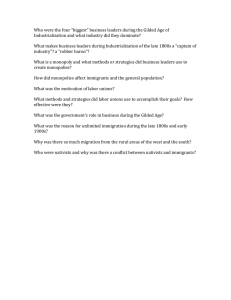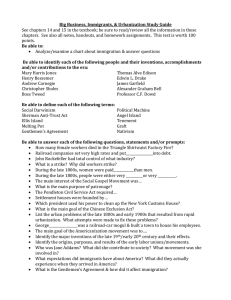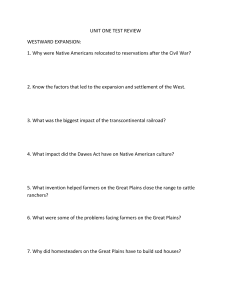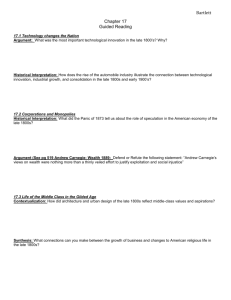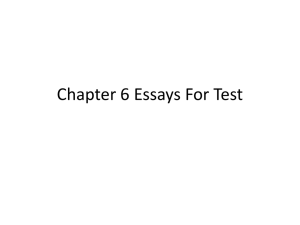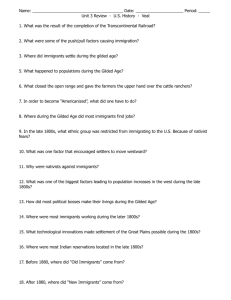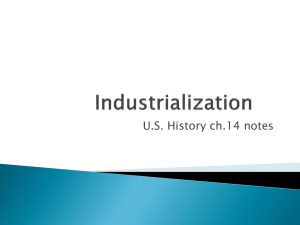1. What major trend related to population
advertisement
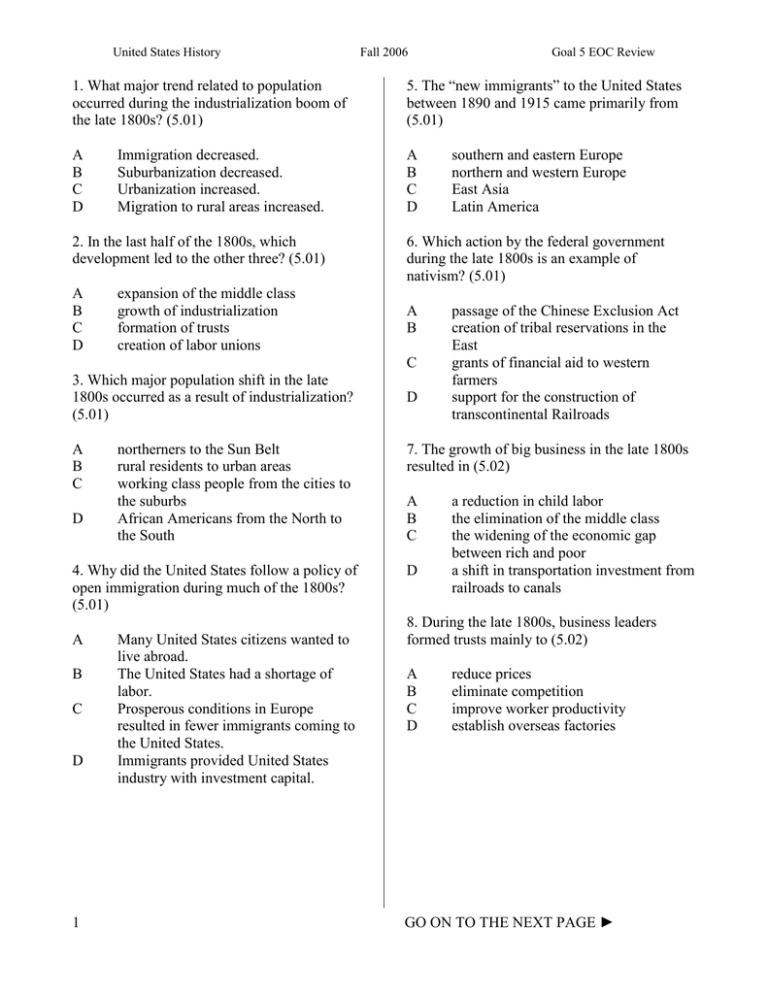
United States History Fall 2006 Goal 5 EOC Review 1. What major trend related to population occurred during the industrialization boom of the late 1800s? (5.01) 5. The “new immigrants” to the United States between 1890 and 1915 came primarily from (5.01) A B C D A B C D Immigration decreased. Suburbanization decreased. Urbanization increased. Migration to rural areas increased. 2. In the last half of the 1800s, which development led to the other three? (5.01) A B C D expansion of the middle class growth of industrialization formation of trusts creation of labor unions 6. Which action by the federal government during the late 1800s is an example of nativism? (5.01) A B C 3. Which major population shift in the late 1800s occurred as a result of industrialization? (5.01) A B C D northerners to the Sun Belt rural residents to urban areas working class people from the cities to the suburbs African Americans from the North to the South 4. Why did the United States follow a policy of open immigration during much of the 1800s? (5.01) A B C D 1 Many United States citizens wanted to live abroad. The United States had a shortage of labor. Prosperous conditions in Europe resulted in fewer immigrants coming to the United States. Immigrants provided United States industry with investment capital. southern and eastern Europe northern and western Europe East Asia Latin America D passage of the Chinese Exclusion Act creation of tribal reservations in the East grants of financial aid to western farmers support for the construction of transcontinental Railroads 7. The growth of big business in the late 1800s resulted in (5.02) A B C D a reduction in child labor the elimination of the middle class the widening of the economic gap between rich and poor a shift in transportation investment from railroads to canals 8. During the late 1800s, business leaders formed trusts mainly to (5.02) A B C D reduce prices eliminate competition improve worker productivity establish overseas factories GO ON TO THE NEXT PAGE ► United States History Fall 2006 Base your answer to questions 9 and 10 on the cartoon below and on your knowledge of social studies. Goal 5 EOC Review Base your answers to questions 11 and 12 on the passage below and on your knowledge of social studies. “. . . This, then, is held to be the duty of the man of Wealth: First, to set an example of modest, unostentatious living, shunning display or extravagance; to provide moderately for the legitimate wants of those dependent upon him; and after doing so to consider all surplus revenues which come to him simply as trust funds, which he is called upon to administer, and strictly bound as a matter of duty to administer in the manner which, in his judgment, is best calculated to produce the most beneficial results for the community— . . .” — Andrew Carnegie, “Wealth,” North American Review, June 1889 11. According to this passage, the responsibility of the wealthy is to (5.02) A B 9. Which economic concept is best illustrated by the cartoon? (5.02) A B C D supply and demand mercantilism monopoly trade 10. What is the main idea of this cartoon? (5.02) A B B D 2 The Standard Oil Company was a harmful monopoly. The best way to develop major industries was to form proprietorships. Government regulations were strangling the Standard Oil Company. Foreign competition in the oil industry was hurting American companies. C D invest in future industry to increase wealth share their excess wealth with the community maintain a lifestyle consistent with their wealth influence government to assist all people 12. Andrew Carnegie carried out the ideas expressed in this statement by (5.02) A B C D funding numerous libraries and educational institutions serving many years in the federal government investing his fortune in several new industries promoting programs to benefit the wealthy GO ON TO THE NEXT PAGE ► United States History Fall 2006 13. Business leaders John D. Rockefeller, J. P. Morgan, and Cornelius Vanderbilt were referred to as robber barons primarily because they (5.02) A B C D Goal 5 EOC Review Base your answers to questions 17 and 18 on the cartoon below and on your knowledge of social studies. bought titles of nobility from foreign governments were ruthless in dealing with competitors stole money from state and local governments gained all of their wealth by illegal means 14. During the late 1800s, the defenders of Social Darwinism would most likely have supported (5.02) A B C D labor unions progressive income taxes laissez-faire capitalism environmental conservation 15. What was the main benefit that labor unions of the late 19th century gained for their members? (5.03) A B C D job security improved wages and hours paid vacations health insurance 16. During the late 1800s, what was the main reason labor unions had difficulty achieving gains for workers? (5.03) A B C D 3 Communists had taken control of the major unions. The government supported business efforts to limit the powers of unions. Most unions had been organized by big business. Most workers were satisfied with working conditions. 17. What is the main idea of this cartoon from the 1800s? (5.03) A B C D Labor is gaining power over big business. Most Americans support the labor movement. Business has advantages over labor. Government should support the expansion of railroads. 18. The American Federation of Labor responded to the situation shown in the cartoon by (5.03) A B C D organizing skilled workers into unions encouraging open immigration forming worker-owned businesses creating a single union of workers and farmers GO ON TO THE NEXT PAGE ► United States History Fall 2006 19. In the late 19th century, the major argument used by labor union leaders against immigrants was that immigrants (5.03) A B C D took jobs from United States citizens contributed little to enrich American life placed financial drains on social services refused to assimilate into American culture 20. Mark Twain labeled the late 1800s in the United States the “Gilded Age” to describe the (5.04) 23. In the late 19th century, Congress tried to limit the power of monopolies by (5.04) A B C D end of the practice of slavery absence of international conflicts extremes of wealth and poverty achievements of the labor movement 21. In the late 1800s, supporters of laissez-faire capitalism claimed that government regulation of business would be (5.04) A B D B C D essential to protect the rights of consumers necessary to provide jobs for the unemployed useful in competing with foreign nations harmful to economic growth restoration of the nation’s cities expansion of opportunities for immigrants improvement in the status of African Americans greater control of government by the people 25. The success of the Populist Party of the 1890s can best be measured by which development? (5.04) A A creating the Federal Trade Commission strengthening the Supreme Court adopting Granger laws passing the Sherman Antitrust Act 24. Which reform idea was a common goal of the Populists and the Progressives? (5.04) C A B C D Goal 5 EOC Review B C D The party replaced one of the two major parties. The party gained support among business leaders. Two of the party’s candidates were elected to the presidency. Several of the party’s proposed reforms were made into laws. 22. In the 19th century, protective tariffs, subsidies for railroads, and open immigration showed that the federal government followed a policy of (5.04) A B C D 4 support for economic development noninterference in the free-market system regulation of unfair business practices support for organized labor GO ON TO THE NEXT PAGE ►
